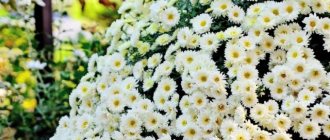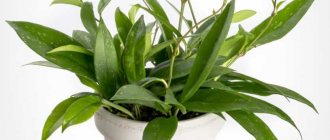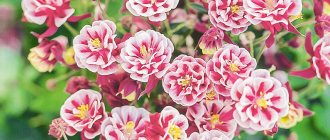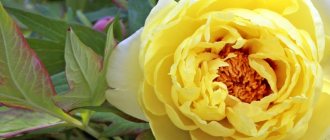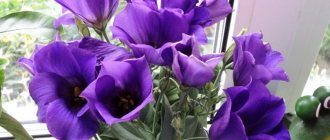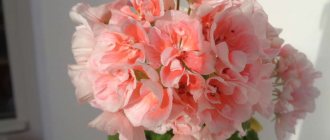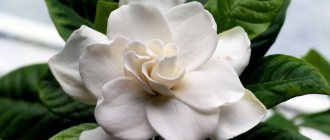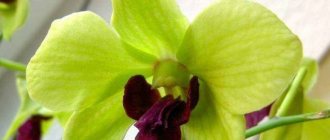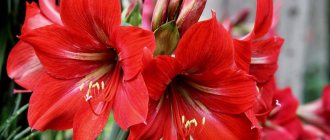Description of the plant
Aquilegia is a spreading bush reaching a height of 1 meter. The root system is strong, thick and well developed, usually not more than half a meter. The leaves are round, lacy, reminiscent of clover. Basal greens grow on long, dissected petioles; on stems they are sessile.
The flowers are drooping to the ground, double and large, can grow up to 10 centimeters. Most have elongated growths - spurs, which are used to collect nectar. The color scheme is different and can combine several shades.
Description of Aquilegia Nora Barlow (with photo)
The plant belongs to the perennial herbaceous crops. Often grows in bush form. The stems are long and may be slightly pubescent. Leaf color ranges from pale light green to rich green with a bluish tint. Terry-shaped petals of various shades. There is a yellow corolla in the center. Popularly, terry aquilegia is called “catchment”; in some regions it is also available as “orlik”. But most often it is called a garden bell. The description of Aquilegia Nora Barlow indicates that it has rather long flowering shoots, due to which the petals collected in double buds can fall down at the moment of full bloom. And on the back of the petals droplets of morning dew collect. This marked the beginning of the popular name “catchment”. Look at the double aquilegia barlow in the photo showing the variety of shades of buds:
Terry Aquilegia Barlow is one of 120 species of this flower crop known to botanists. Used for landscape design, park decoration, flower beds and flower beds. It has a powerful root system that can reach more than 1 meter deep into the soil layer. Due to this, it rarely needs additional watering. But regular feeding with minerals stimulates abundant flowering and more saturated color of the petals. The height of an adult bush reaches 120 cm; feathery, torn leaves with a bluish coating provide an excellent background for blossoming buds. Flowering is very long - it begins in mid-June and ends only after the establishment of permanent snow cover in late autumn.
Varieties of Barlow
Aquilegia Barlow is a hybrid of the common eagle and other hybrids, rarely found in the wild.
Barlow Pink
Flowers: bright red. Height: 80 centimeters. Flowering period: 2 months. Preferences: shady areas and high humidity.
Barlow Winky
Flowers: double, not drooping, of various colors. Height: 50 centimeters. Flowering period: May-August. Features: frost resistance and wind resistance.
Krista
Flowers: purple, drooping at the end of the day. Preferences: partial shade.
White
Similar to the variety Krista. The only difference: the color of the flowers is white.
Nora Barlow
Flowers: white-pink, sometimes white-red, with a dark core, large, double. Height: 70 centimeters. Shape: spreading.
Types and varieties
Aquilegia varieties are divided into more than 100 species. It will not be possible to list them all in one article, so below are descriptions of the most popular types. About 30 species grow in Russia.
Mr Scott Elliot
Aquilegia Mr. Scott Elliot
The Mr. Scott Elliot variety is a perennial up to 80 cm high. The diameter of the flowers is 10 cm. They have a variety of colors. This variety is winter-resistant and unpretentious, blooms in spring and early summer. Grows well in shaded areas.
Ruby Port
Aquilegia Ruby Port
Ruby Port (Aquilegia Ruby Port) reaches a height of 60 cm. The flowers are rich red with a yellow corolla.
Aquilegia Dark
Aquilegia dark
Aquilegia Dark grows in the Alps. This is a fairly tall plant. Its height reaches 80 cm, although there are also low-growing varieties, no higher than 30 cm. Drooping flowers of this species are 3-4 cm in diameter. Colors vary from purple to black-blue. There is often a white border near the throat of the corolla.
Aquilegia terry
Aquilegia terry
This type of flower was artificially bred by breeders. Terry aquilegia is distinguished by lush flowers on shoots up to 100 cm long. Flowers with a diameter of up to 10 cm. The color often changes shade from the base to the edge.
"Yellow Crystal"
Aquilegia "Yellow Crystal"
The watershed variety Yellow Crystal reaches a height of 80 cm. These are unpretentious frost-resistant herbaceous plants. They grow best in partial shade, on loose, humus and moist soil. The flowers are solitary with one elongated spur. The variety got its name because of the yellow color of the flowers.
Blue ice
Aquilegia Blue Ice
Miniature Aquilegia blue ice blooms from mid-May to mid-July. This species has large purple flowers interspersed with creamy white.
Blue Star
Aquilegia Blue Star
Tall aquilegia Blue Star with blue-blue flowers up to 10 cm in diameter. The leaves are openwork blue-green. This variety is unpretentious and blooms profusely in the second year after planting.
Plants of the hybrid Blue Star variety look great in mixed flower beds, in combination with ferns, irises and bells.
Clementine
Aquilegia Clementine
The Clementine variety looks very similar to clematis flowers, hence the name. Flowers without spurs. The variety blooms very profusely. The height of the plant is average, no more than 40 cm. It is good to plant this species in rockeries and pots.
Canadian
Aquilegia Canadiana
The Canadian Aquilegia species is native to North America and is practically not found in Europe. The flowers are red-yellow with spurs. This variety is tall - up to 60 cm in height.
Skinner
Skinner's Aquilegia
A beautiful variety of Skinner's aquilegia has drooping red-yellow flowers with straight spurs. This species is not frost-resistant - the plant must be covered for the winter. Native to southern North America.
Crimson Star Christmas star
Aquilegia Crimson Star
The type of aquilegia Crimson Star is of medium height, up to 50 cm. The flowers are white-red, up to 6 cm in diameter, the leaves are decorative dark green. This variety blooms in mid-summer - June or July.
Tower White
Aquilegia white tower
The Tower White or White Tower is quite tall, reaching 80 cm in height. The flowers are perfectly white, the inflorescences are 4-5 cm in diameter.
Nora Barlow
Aquilegia Nora Barlow
The species Nora Barlow, named after Charles Darwin's grandmother, has been cultivated since the 17th century. The plant is about 70 cm high. The flowers are white-pink, double. The shape of the plant, compared to other species, is spreading.
Giant Mac Cana
Aquilegia Giant Mac Cana
Mac Canas are tall hybrids. They can reach a height of 120 cm. Because of this, the variety is sometimes called giant. The flowers have long spurs. The colors of the petals and sepals usually vary. There are blue, blue, light purple, white, yellow, pink, red and dark red colors.
The Mac Cana lime sorbet hybrid is characterized by white double flowers.
Aquilegia Barlow black also belongs to the Mac Cana variety. Erect stems may be slightly drooping. The flowers are a rich dark purple, almost black. Hence the name - Aquilegia Black.
Red Star
Aquilegia Red Star
The Red Star aquilegia variety is a tall variety - up to 80 cm in height. The flowers are star-shaped, red and white, about 10 cm in diameter.
"Birds of Paradise"
Aquilegia "Birds of Paradise"
The Birds of Paradise variety is characterized by large multi-colored double flowers. Upon closer inspection, it seems as if the inflorescences consist of birds sitting next to each other.
Alpine
Aquilegia alpine
As the name suggests, Aquilegia alpine grows in the Alps. The flowers of this species are large, blue-violet in color. The best soil for this variety is sandy and loamy. Since the plant’s usual habitat is in the mountains, it is used to create rocky and alpine slides.
"Winky"
Aquilegia "Winky"
Frost-resistant species with straight short stems. Varieties of this variety include, in particular, Aquilegia Vinca double red and white. Due to its short stature, the plant does not require staking and is very resistant to winds.
Golden-flowered
Aquilegia goldenflower
Aquilegia golden-flowered is found in the territory from the south of North America to the north of Mexico. The flowers are large and yellow. Like all species from America, spurs are present. The plant is very tall - up to 100 cm. This species looks great against the backdrop of an emerald lawn.
Aquilegia vulgaris
Aquilegia vulgaris
Aquilegia vulgaris grows in Europe. Plants of this species reach a maximum of 70 cm in height. Flowers can be blue, purple or pink. This species is the most frost-resistant, withstands temperatures down to -35 C.
Aquilegia vulgaris Barlow blue is distinguished by double blue flowers. Stems are erect. The plant is about 80 cm in height. It blooms in June-July. Aquilegia vulgaris William Guinness grows up to 75 cm in height. The flowers are double, dark lilac.
Biedermeier
Aquilegia Biedermeier
Aquilegia of the Biedermeier species is characterized by double flowers of small diameter. This plant is perfect for growing in pots, as its height does not exceed 30 cm.
Fan-shaped
Aquilegia fanata
Some varieties of this species bear the names of North American states. For example, Alaska or Colorado. The height of the plant reaches 80 cm. The corolla is large, the shades are varied.
Specifics of growing flowers
Aquilegia is very unpretentious, but there are still some peculiarities when growing.
Site selection and preparation
The ideal place for aquilegia is partial shade, since the complete absence of sun will reduce the number of flowers, and constant direct light will not only affect the brightness, but can be destructive for the plant. If there is no shadow on the site, then the seat should be shaded. It is better to choose loamy and moist soil. You should first dig up the bed and get rid of the weeds.
See also
Planting and caring for perennial garden spurge, propagation and cultivationRead
Preparation of planting material
Planting material, namely aquilegia seeds, collected immediately after falling, is wrapped in a damp cloth and left to ripen in a cold, dry place, possibly in the refrigerator, and then planted. If planting occurs with the help of seedlings, then the seeds are also allowed to ripen by cooling, and then the following preliminary steps are performed:
- lower the seed 3 centimeters into pre-prepared containers with soil;
- sprinkle a little peat on top;
- carefully pour warm water and cover with film to create a “greenhouse” effect;
- then water with a small amount of water every 2-3 days;
- after three weeks, having noticed the emergence of seedlings, the film should be removed;
- After 4 leaves appear, the seedlings are ready for planting in the garden.
Planting scheme
As already mentioned, there are two options for planting aquilegia: seeds and seedlings. Rules for planting seeds:
- End of August - beginning of September:
- prepare the seat;
- place seeds;
- sprinkle with earth - about 1.5 centimeters;
- water a little;
- mulch with humus or peat.
- In spring, after the snow melts: after cooling, sow the seeds in a prepared place, controlling the moisture balance.
Transplanting seedlings:
- in June: seedlings are planted in prepared soil at a distance of 20 centimeters from each other, trying not to damage the roots.
Aquilegia Hybrid
The name itself indicates that breeders have worked to improve both the shape and size of the flower, and the versatility of its color. Breeders managed to achieve such results by crossing the watershed of an Alpine and an American plant variety.
Aquilegia hybrid is distinguished by its tall growth - shoots can reach 1 m in height. And the flowers themselves are quite large - up to 10 cm in diameter. If we talk about the number of flower petals of this variety, they can be standard - 5 main ones and 5 spurs. In other variations of the variety, the number of petals can be significantly greater and thus form a double or fan-shaped flower.
The most common color options are a combination of white with blue or red. Monochromatic coloring of the peduncle is also common.
Important ! If you want to get an abundant flowering cap on your flowerbed or lawn, then you should choose hybrid aquilegia, as they are distinguished by abundant simultaneous flowering, which lasts quite a long time.
This variety is also suitable for growing in more northern regions than it usually grows - it is quite frost-resistant and unpretentious in care.
Aquilegia Hybrid
Plant care
In order for aquilegia to grow strong and healthy, you should follow basic rules of care.
Weeding and loosening the soil
Loosening the soil by no more than 20 centimeters is carried out after each watering or rain to prevent oxygen stagnation. You should also remember to weed when weeds appear.
Watering
Aquilegia loves humidity, but the plant should not be flooded. It is enough to water as soon as the soil dries. It is advisable to use irrigation products to simulate rain, since the leaves of the plant love to absorb raindrops. In rainy summers, additional moisture is not needed.
The soil
Aquilegia roots often break through the ground, so the plant needs to be replenished with soil annually, while removing an 8-centimeter layer of the old one.
Top dressing
The best time to apply organic or mineral fertilizers is cloudy or rainy weather. If the summer turns out to be sunny, then you should feed the aquilegia in combination with watering in the evening, and then shade it well for a day. Fertilizers are applied in May, June and after flowering.
How to care for aquilegia after flowering?
After flowering of the aquilegia, it is necessary to prune the shoots that have lost their vigor to a leaf rosette. Healthy cuttings will make excellent compost; infected and weak ones should be burned. Also, the period after flowering is the best time to divide the plant and collect seeds.
See also
Rules for planting and caring for perennial echinacea, 10 best varieties for open groundRead
Winter care
Aquilegia is frost-resistant, however, when it reaches 5 years of age, the roots of the plant come to the surface and require shelter in winter. To do this, the bush should be mulched with humus and peat compost and sprinkled with fresh soil. Preparatory measures for cold weather should begin in the fall.
Trimming
As already mentioned, pruning of aquilegia is carried out after flowering to avoid random self-seeding and rejuvenate the bush.
Care during the flowering period
Caring for aquilegia during the flowering period is not difficult. It includes loosening the soil, as well as fertilizing the bushes with organic and mineral complexes. When flowering ends, the flower stalks are cut off at the level of the lower leaves. The average lifespan of a shrub is from 5 to 7 years. Then it is better to replace it with a young specimen.
Wintering
Aquilegia terry is characterized by a high level of winter hardiness. However, when the plant reaches the age of 5 years, its root system begins to make its way to the surface. Therefore, the shrub needs to provide additional shelter in winter. To do this, the crop is mulched with humus and peat compost, and then sprinkled with fresh soil.
You need to start preparing shrubs for wintering in mid-autumn.
Control of diseases and pests of aquilegia
The Elven slipper is susceptible to the following diseases:
- powdery mildew - appears with a lack of sunlight and high humidity. Prevention - treating greenery with a sulfur solution. Treatment – folk and chemical means;
- mosaic is the most dangerous, incurable disease. If symptoms are detected, the bush should be dug up and burned;
- gray rot - at the initial stage it is possible to treat with Fundazol, if it is advanced - digging up the plant and further burning it.
Among the pests, aquilegia can be attacked by aphids, caterpillars and mites. Folk remedies or chemicals should be used against them. If left untreated, the plant may die in a couple of days.
Aquilegia vulgaris
The usual distribution area of this flower is in the European part of the Eurasian continent.
It differs in height, ranging from 30 to 70 cm - depending on the conditions that exist in a certain region or season.
The main part of the leaves of the variety are located at the base of the petiole and leaves are much less common along the length of the stem. They are double trifoliate, with a slight bluish coating.
Note! Flowers of this variety are distinguished by the fact that they have a small variety of petal colors. Most often these are blue, purple and pink shades.
If we talk about the size of the peduncle, then it is quite average in size. Only 4, maximum 5 cm in diameter. As for the number of petals, they can be standard and include 5 main and 5 spurs. Other variations include double flowers.
Important ! This variety can withstand frosts that last quite long and with temperatures down to -35°C. Therefore, it can be planted even in regions where winter temperatures are quite extreme or in areas that are high above sea level.
It is all of the above characteristics of this variety of aquilegia that make growing and caring for it quite easy.
Aquilegia vulgaris
Reproduction
The bush can be propagated in several ways.
Seeds
Aquilegia seeds are collected after flowering. To do this, the future “parents” should wear a gauze bag to collect seeds so as not to collect them from the ground. However, the chance of getting a flower identical to the mother is very low, since the plant interpollinates.
Dividing the bush
Dividing aquilegia is not the best method of propagation, as it can cause harm to the plant. An adult bush that has reached 5 years of age is suitable for this method:
- Divide the dug root into parts with a knife, leaving 3 buds on each;
- plant the divided root in the holes and water immediately;
- Feeding should be carried out only after grafting.
We take cuttings in the spring
The surest way to get the original appearance of a flower. To do this, use young spring shoots, cut off before the greenery blooms:
- cut the cuttings close to the soil;
- treat the cut with a root growth stimulating agent;
- fertilize the planting site with sand and peat and moisten it;
- Plant the cuttings a centimeter deep;
- the bed must be shaded;
- landing at a permanent place occurs in August.
Aquilegia Terry
Aquilegia Terry is an unusual variety of plant, which is distinguished by its largest flowers, reaching a diameter of 10 cm. It was bred artificially in order to diversify the flowers and achieve a certain effect.
A distinctive feature is its multi-petal structure. The flower itself is formed from narrow petals arranged in several rows. When it comes to coloration, the intensity of the color decreases as it approaches the center. Shades can range from white to lilac.
The leaves of this plant variety have a specific bluish coating.
Note! When breeding Aquilegia Takhrova, breeders managed to achieve higher frost resistance. This makes it possible to grow a plant of this variety in regions more northern than its natural distribution area.
This is what ensured the great popularity of the variety among gardeners.
Aquilegia Terry
Flowers in landscape design
Aquilegia feels natural in wooded and mountain gardens. Their fine, fan-shaped foliage is a great contrast to ferns and Hosta, and because they hold their flowers high above the base of the plant, they combine well with other shade lovers such as Hellebore and Dicentra.
You can plant aquilegia in containers, but the flowers need regular watering.
Aquilegia Columbine
This is a perennial with a compact but fairly tall bush - up to approximately 70 cm. The variety is cold-hardy, which makes it, like Aquilegia Ordinary, a suitable species for growing in the Siberian regions.
A distinctive feature of Aquilegia Columbina is its more elongated flower shape, reminiscent of a bell-shaped bowl. The shades of the petals can vary from the lightest (white) to deep dark purple.
Aquilegia Columbine
In what conditions is it best to grow?
Aquilegia feels more comfortable in the garden, in partial shade in open ground. But this does not mean that it cannot be planted in a sunny area. However, in this case, the flowers of the plant are quickly crushed, and they will not look so chic.
The flower is calm about soil fertility, although it prefers loose, light and moderately moist soils. Therefore, when planting, you need to add a little humus or compost, thoroughly digging up the substrate.
Well-groomed aquilegia flowers on a personal plot.
A path of aquilegias of various colors. An interesting combination of white, purple, crimson and yellow will be the highlight of any stylish flower bed.
An exquisite classic - red aquilegias at the doorstep.
Aquilegia Yellow
Another perennial plant hybrid is the Yellow Aquilegia variety. Its distinctive feature is golden flowers of a single color, which have a fairly standard shape, characteristic of a wild-growing catchment. This species is popular in North America, but recently it has become increasingly in demand among domestic gardeners. This is due to the fact that bright flowers of a rich yellow hue begin to bloom quite early and continue to send out flower stalks abundantly throughout the summer.
As for growing regions, it feels best in regions with a temperate continental climate.
Aquilegia Yellow
What does the aquilegia flower look like and where does it grow?
Aquilegia belongs to the Buttercup family. These flowers are also called columbine, bell, eagles, booties and doves.
Aquilegia grows in the Northern Hemisphere. It was brought to Europe from North America. Most of the catchment species can be grown in any region of Russia without shelter, including in the taiga.
Appearance of aquilegia:
- height 0.4-1.2 m;
- leaves are trifoliate, petiole long and flexible;
- flowers are solitary (in some varieties they may be in inflorescences), drooping, of various sizes, single-color or two-color;
- the color is white, yellow, pink, crimson, blue, blue and violet, in American varieties it is golden, orange and red;
- the corolla has 5 separate petals resembling a funnel, spurs of different lengths and shapes - they are absent in Chinese and Japanese varieties;
- The fruit is multi-leafed with small black seeds.
The common columbine is the type species of its genus
Growing aquilegia from seeds
The seeds of the plant are used for sowing immediately after they are collected, that is, in the fall. However, if this could not be done immediately, then it is better to store them until spring in a cold place, after mixing them with soil.
When spring comes, the seeds require washing, then they can be planted in boxes, in the so-called soil, consisting of equal proportions of sand, humus and leaf soil. A thin layer of soil is poured over the sown seeds and covered with newspaper or burlap. The aquilegia flower is a lover of shaded places and relative warmth, not higher than +18, it needs constant light watering. The first shoots can be expected after two weeks. As soon as the first leaves appear on the horizon, this is a sign for seedlings to spread over a larger area.
Aquilegia - lover of shady places
